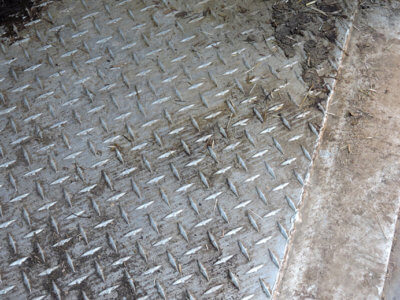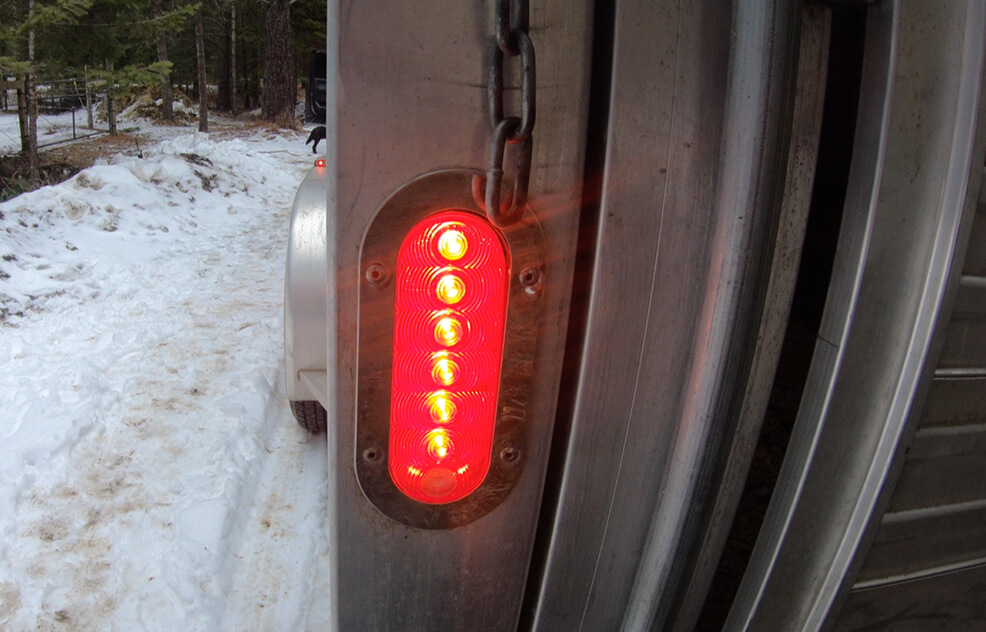Before you head out on a riding or camping adventure you need to do your horse trailer’s yearly safety checks and service. If you aren’t mechanically savvy (or just not inclined to do the job yourself) a qualified professional can do all the work for you. Just make sure they know what you want examined, as the mechanic may not be familiar enough with horse trailers.
Trailer Tires: Four Priorities
- Check tire pressure.

Underinflated tires are one of the most common issues drivers face with their horse trailer. Underinflation causes preventable wear to the tires and can even cause a blowout, derailing your trip before it gets started. Due to trailer tires’ stiff sidewalls, most won’t bulge out when the pressure is low like a car’s do. The only way to accurately check the psi (pound-force per square inch) is with a quality pressure gauge.
When checking tire pressure, look for the psi recommendation from the trailer manufacturer. The psi should be listed in the owner’s manual or on a plaque on the trailer body. The tire inflation recommendation is according to the max load capacity of the trailer itself, not the amount written on the side of the tire.
Check your trailer tires cold — either before you drive or at least 3 to 4 hours after a trip. Then use the pressure gauge. Once you have a reading, you’ll know if your tire’s psi is under or over the recommended amount, and you can act accordingly.
- Visually inspect the tread and sidewall.
While you’re checking your tires’ air pressure, look for cracking, deep cuts, foreign objects that may be caught in the tread, or bulges on the sidewall that may indicate a broken cord. Tires that are overly worn or cracked can lead to potential blowouts, putting you and your loved ones at risk.
If you see cracks on the circumference and surface of your trailer tires, be careful. This indicates dry rot, which makes tires more susceptible to leaks and tread separation. More horse trailer tires wear out from rot than from road miles. Trailers often sit for prolonged periods, creating flat spots in the tires that are high-risk for separation. Additionally, UV light from the sun contributes to cracking and premature aging.
Finally, make sure there’s a valve cap on every tire. These cost just a few dollars but protect the tire valve from damage and give added protection against slow leaks through the valve itself.
- Measure tread depth.
Tread depth is the measurement from the top of the tread to the bottom of the tire’s deepest grooves. It determines if the tire can maintain safe tracking and handling performance. An easy way to tell if the tires are near the end of their life is by using a penny to confirm the tire’s tread depth. If Lincoln’s entire head is visible, then the tire is considered worn out (in most instances) and should be replaced.
- How old are your trailer tires?
All tires sold in the US have a Department of Transportation code which indicates the tire meets all federal standards. These identification numbers also include the tire’s date of manufacture. It’s recommended to replace all trailer tires every 3 to 7 years. When purchasing new trailer tires talk to the dealer to ensure the product that you are receiving has been recently manufactured.
Your tire’s date code begins with “DOT”. The DOT should be followed by a series of letters and numbers. The last four digits of this code tell you the date when your tire was manufactured. The first two numbers indicate what week of the year it was made (out of 52 weeks per year), and the second two numbers represent the year. For example, 3408 would reveal that a tire was manufactured during the 34th week, or mid-August of the year 2008.
By taking these easy steps, you can extend the life of your tires while decreasing your risk. Don’t forget to check your spare tire.
Inspect Your Trailer Floor
 It’s imperative that the trailer floor be in good condition. Take out the mats and check the floor for soundness. Your horses are counting on it.
It’s imperative that the trailer floor be in good condition. Take out the mats and check the floor for soundness. Your horses are counting on it.
If you have a wood floor, test its integrity with a screwdriver or a knife. Try to stick a screwdriver into the surface and twist it. If the wood crumbles easily it’s time to replace the floorboards. Do the same from underneath. Rot can be hiding where you can’t easily see it.
If you have an aluminum floor, check for corrosion or pitting. Also check the welds for cracks. If you see a potential problem, contact the dealer.
Inspect Your Trailer Lights
Turn on the lights. Are all the taillights, stop lights, clearance lights and turn signals working properly? Replace bulbs as necessary. Verify that the trailer’s electrical connection to your vehicle is clean and tight.
Inspect the Safety Chains
Trailer safety chains are the first line of defense in case anything causes a sudden disconnection of tow vehicle and trailer. If your ball or coupler do fail, your safety chains will allow you to guide your trailer and ease your way into a stop.
Check the chains for wear and tear. Replace as needed. When connected, the chains should not drag on the ground or be twisted to shorten them. Ensure that the chains are attached to the frame of the towing vehicle, not to any part of the hitch.
Safety chains should never be overlooked for regular maintenance. They’re the glue holding your towing adventure together.
Inspect the Breakaway Battery and Switch
The trailer breakaway system is designed to automatically bring the trailer to a safe stop should the trailer be disconnected from the tow vehicle while driving. For this to happen you must have operational electric brakes on the trailer, the 12-volt battery must be charged, and the switch cable must be attached to the towing vehicle.
Ensure that the breakaway cable is not attached to the hitch or the safety chains (neither is legal nor safe). The breakaway cable should be attached to a part of the tow vehicle that cannot fall off, such as the frame.
Here’s a quick way to check if the breakaway system is working: hook up the trailer but keep the trailer electrical plug disconnected. Pull out the pin from the breakaway switch. Slowly pull the tow vehicle forward. If the trailer brakes lock up and the wheels won’t turn, your breakaway system is functioning. If your trailer rolls without restraint, you need to have the system repaired. Re-insert the pin into the switch.
Inspect the Trailer Jack
Operate the jack to ensure that it raises and lowers smoothly when lifting the trailer to connect and disconnect from the tow vehicle.
Ensure the jack is stable and tightly fastened to the trailer. For swivel jacks, check mounting/swivel hardware for worn or broken parts. Grease if needed.
Inspect the Inside of the Trailer
Look inside the trailer for any potential problems. Do all moving parts, doors, and latches work properly? Ensure that no unwelcome animals or insects have built homes since the trailer was last used.
Wheel Bearings and Hubs
Trailer wheel bearings need regular maintenance, and with extensive towing they’ll need to be replaced. The bearings are located within the wheel hub and reduce the friction between the wheel and wheel assembly. Because the bearings are hidden from plain view, it’s crucial to remember to take the necessary time to open the wheel hub and inspect.
Wheel hubs connect the trailer tires to the axle and allow them to spin. Check to see if they are damaged, corroded or improperly installed in order to avoid issues such as impaired steering or a broken axle.
Brake Shoes and Drums
Properly functioning brake shoes and drums are essential to ensure everyone’s safety. As such they should be inspected for excessive wear or heavy scoring. Depending on the amount of wear, the drums may have to be turned or replaced.
Regular trailer maintenance is critical to ensuring the longevity of your trailer, as well as ensuring you arrive at your destination safely. If you have specific questions regarding your trailer, consult your owner’s manual or your dealer.
As always, for more practical information on trail riding, camping with horses, or tips on getting to the trailhead safely, visit www.TrailMeister.com. It’s also the world’s largest and most accurate guide to horse trails and camps.
See this article in the June 2021 online edition:

Robert Eversole, ”the trail meister,” owns www.TrailMeister.com, the largest database of horse riding and camping areas in the U.S. with free trail and trailhead information, trail maps, and much more to help horse enthusiasts experience the joys of trail riding. Robert is a registered riding instructor with PATH International, a mounted search and rescue team member, and a U.S. Marine who has served on the board of the Backcountry Horsemen of Washington (BCHW). He is enjoying his new career helping fellow trail riders stay found and safe on the trail. When not on the trail, The Trail Meister resides near Spokane, WA and teaches land navigation to a wide variety of outdoor groups across the nation. For North America’s largest horse trail and camping directory, trail tips, and more, visit www.TrailMeister.com.






